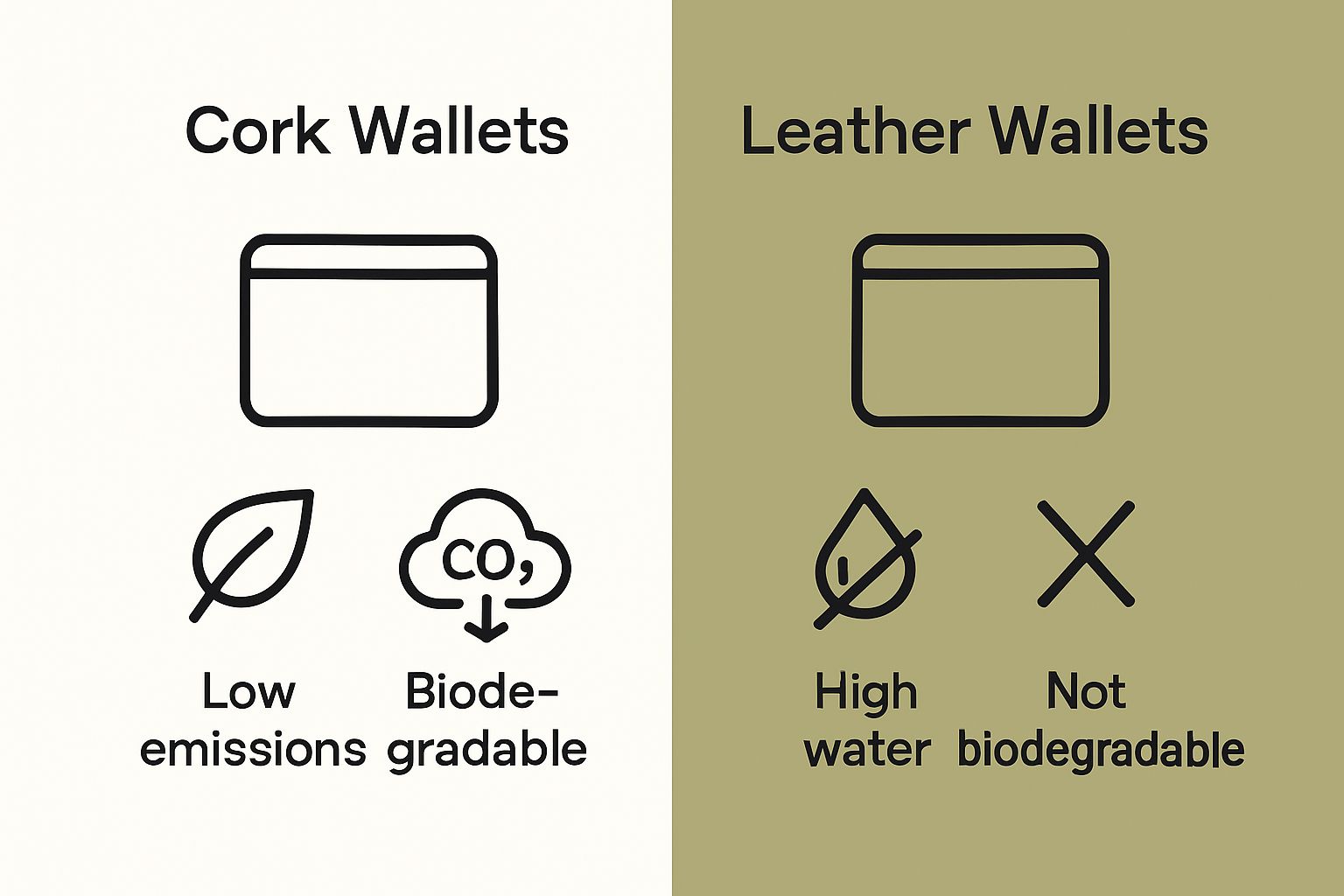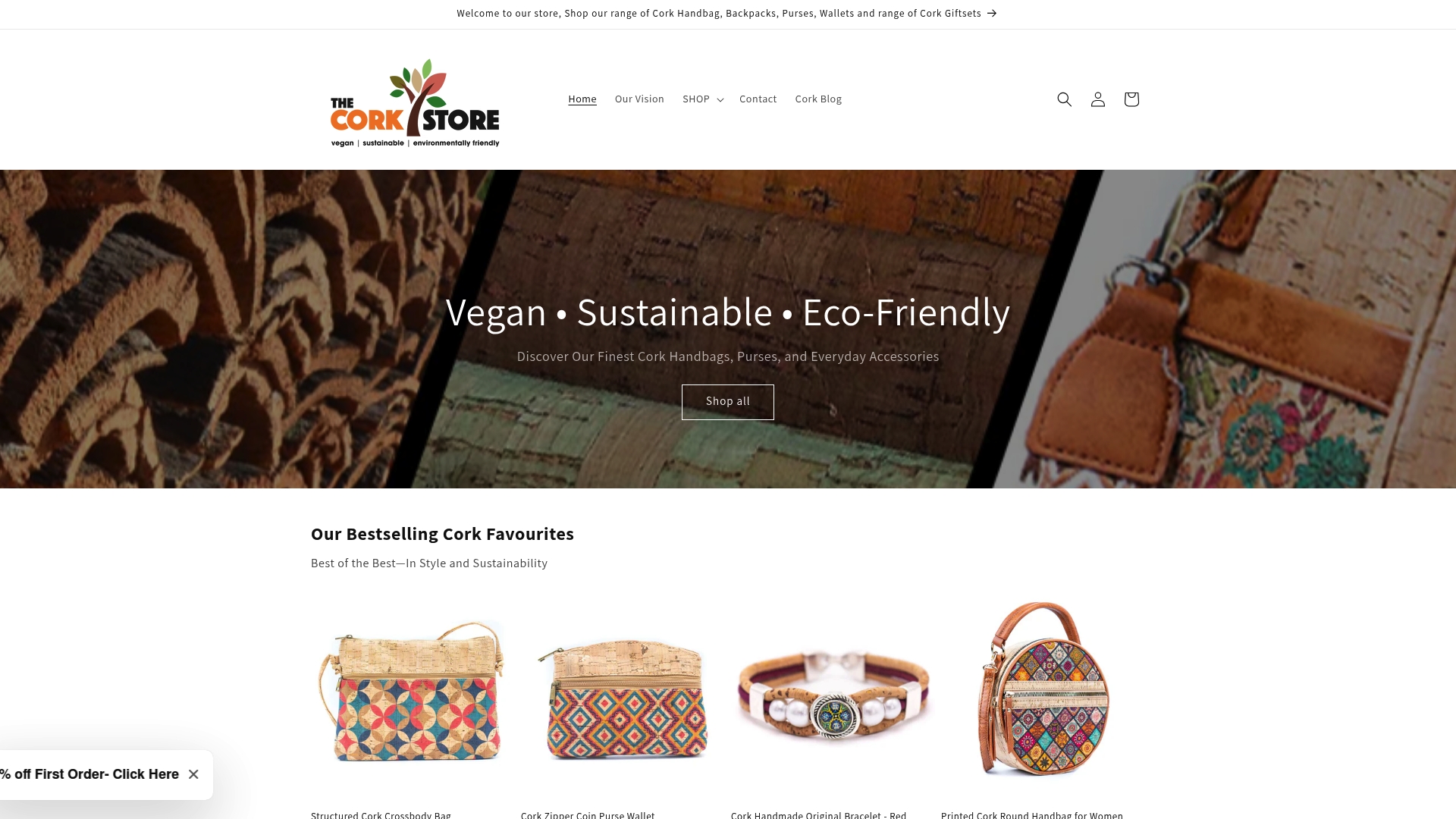
Understanding the Benefits of Cork Wallets
Share
Cork wallets are changing the way people think about everyday accessories. Most might expect their eco appeal to come with a trade-off in quality, but research has found that cork is actually more durable and water-resistant than many traditional leathers. Style and sustainability might sound like opposites. Here, they come together in a wallet that outperforms expectations on every level.
Table of Contents
- What Are Cork Wallets? Definition And Characteristics
- Why Choose Cork? The Environmental Impact Of Cork Wallets
- Benefits Of Cork Wallets: Style, Durability, And Practicality
- How Cork Wallets Are Made: Sourcing And Production Processes
- Cork Wallets In The Fashion Industry: Trends And Consumer Preferences
Quick Summary
| Takeaway | Explanation |
|---|---|
| Cork wallets are eco-friendly alternatives | They provide a sustainable option to leather, crafted from harvested cork oak bark. |
| Cork harvesting is sustainable | The process does not harm trees and allows for repeated extractions every nine years. |
| Cork wallets offer unique design advantages | Each wallet features a distinctive pattern, ensuring individuality and style. |
| Cork material is durable and practical | Cork wallets resist wear, moisture, and maintain structural integrity over time. |
| Purchasing cork supports environmental consciousness | Choosing cork wallets impacts demand for sustainable accessories and encourages eco-friendly practices in fashion. |
What Are Cork Wallets? Definition and Characteristics
Cork wallets represent an innovative, sustainable alternative to traditional leather accessories. Crafted from the bark of cork oak trees, these unique wallets offer a remarkable combination of functionality, durability, and environmental responsibility. Understanding why cork wallets are transforming eco-friendly fashion reveals their growing popularity among conscious consumers.
The Origin and Composition of Cork Wallets
Cork wallets are made from the harvested bark of cork oak trees, primarily found in Mediterranean regions like Portugal and Spain. The material undergoes a meticulous processing technique that transforms raw cork bark into thin, flexible sheets suitable for crafting accessories. Unlike traditional leather production, cork harvesting is sustainable and does not harm the tree, allowing repeated extraction over its 200-year lifecycle.
Key characteristics of cork material include:
The table below outlines the main characteristics of cork material as described in the article, highlighting what makes it particularly suitable for wallet production.
| Characteristic | Description |
|---|---|
| Lightweight | Easy to carry, does not add unnecessary bulk |
| Water-resistant | Protects contents from moisture and humidity |
| Naturally antimicrobial | Inhibits microbial growth and odours |
| Highly flexible | Adapts easily to various wallet designs |
| Biodegradable | Breaks down naturally without harming environment |
| Durable | Resistant to wear, maintains shape and structure |
- Lightweight and incredibly thin
- Water-resistant and naturally antimicrobial
- Highly flexible and adaptable to various designs
- Biodegradable and environmentally friendly
Design and Functional Advantages
Cork wallets distinguish themselves through unique design elements and practical benefits. According to research from environmental sustainability experts, cork’s cellular structure provides exceptional durability and resilience. These wallets typically feature minimalist designs that prioritize functionality, offering multiple card slots, a compact profile, and smooth texture.
The material’s inherent properties make cork wallets ideal for individuals seeking an alternative to conventional leather accessories. They resist wear, maintain structural integrity, and provide a tactile experience that combines modern aesthetics with ecological consciousness.
To help readers quickly compare cork wallets and traditional leather wallets across relevant criteria, the table below summarises key differences mentioned in the article.
| Feature/Aspect | Cork Wallets | Traditional Leather Wallets |
|---|---|---|
| Material Source | Bark of cork oak trees (renewable, sustainable) | Animal hide (resource intensive) |
| Harvest Impact | Tree is unharmed, allows repeated extraction | Animal must be killed for hide |
| Durability | Highly durable, resists wear and moisture | Durable, but can degrade from moisture |
| Water Resistance | Naturally water-resistant, anti-microbial | Often requires treatment for water-resist. |
| Environmental Footprint | Low: biodegradable, low emissions, minimal water | High: water-intensive, polluting chemicals |
| Design/Aesthetic | Unique natural patterns, lightweight, slim profile | Less variation, heavier |
| Biodegradability | Fully biodegradable | Decomposes slowly; not always biodegradable |
| Whether you prefer a slim cardholder or a more traditional bifold design, cork wallets deliver both style and substance. |
Why Choose Cork? The Environmental Impact of Cork Wallets
Choosing a cork wallet extends far beyond personal style, representing a significant commitment to environmental sustainability. These accessories embody a powerful narrative of ecological responsibility, transforming consumer choices into meaningful environmental action. Our guide on eco-friendly fashion choices highlights the profound impact of sustainable material selection.
Sustainable Harvesting and Carbon Sequestration
Cork oak forests are remarkable ecosystems that play a critical role in global environmental preservation. Research from environmental conservation experts reveals that cork harvesting is a unique process that does not harm the tree, allowing it to continue absorbing carbon dioxide throughout its lifecycle. The cork oak tree can be harvested approximately every nine years, making it an exceptionally renewable resource.
Key environmental benefits of cork production include:
- Preservation of biodiversity in Mediterranean landscapes
- Significant carbon dioxide absorption
- Protection of endangered plant and animal species
- Minimal ecological disruption during material extraction
Reducing Environmental Footprint Through Conscious Consumption
By selecting a cork wallet, consumers actively participate in reducing environmental degradation associated with traditional leather production. Cork manufacturing requires minimal processing, uses significantly less water, and generates substantially lower carbon emissions compared to conventional leather or synthetic wallet materials.
Moreover, cork wallets represent a circular economy approach. The material is biodegradable, meaning it can naturally decompose without leaving harmful residues in the environment. This characteristic stands in stark contrast to synthetic wallets made from petroleum-based materials that can persist in landfills for hundreds of years.

Consumer choices matter. Each cork wallet purchased signals a demand for sustainable, environmentally conscious fashion accessories, encouraging broader industry transformation towards more responsible production methods.
Benefits of Cork Wallets: Style, Durability, and Practicality
Cork wallets represent more than just an eco-friendly accessory, offering a sophisticated blend of aesthetic appeal, exceptional durability, and remarkable practicality. Discover unique cork gift ideas that showcase the versatility of this extraordinary material.
Unparalleled Style and Aesthetic Versatility
The unique texture and natural variations of cork create wallets with extraordinary visual character. Unlike mass-produced leather accessories, each cork wallet carries its own distinctive pattern, ensuring that no two pieces are exactly alike. According to material science research, cork’s cellular structure enables designers to create sleek, modern designs that appeal to contemporary fashion sensibilities.
Key aesthetic advantages include:
- Natural, organic appearance with subtle texture variations
- Lightweight and slim profile
- Available in multiple colours and finishes
- Minimalist design potential
Exceptional Durability and Performance
Cork wallets demonstrate remarkable resilience that challenges traditional perceptions of alternative materials. The inherent cellular structure of cork provides natural shock absorption and resistance to wear, making these wallets significantly more durable than conventional leather alternatives. They maintain structural integrity even with frequent use, resisting moisture, scratches, and daily friction.
The material’s unique properties ensure:
- Resistance to tearing and puncturing
- Ability to retain shape over extended periods
- Natural water and stain repellence
- Longevity that surpasses traditional wallet materials
Beyond physical durability, cork wallets represent an investment in both personal style and sustainable consumption. Their combination of aesthetic appeal and practical performance transforms them from mere accessories into statements of conscious consumer choice.

How Cork Wallets Are Made: Sourcing and Production Processes
The journey of a cork wallet from forest to fashion accessory involves a sophisticated, environmentally conscious process that transforms raw natural material into a sophisticated product. Learn more about cork leather and its unique manufacturing process to appreciate the craftsmanship behind these innovative accessories.
Sustainable Cork Harvesting Techniques
Cork production begins in the ancient cork oak forests of Portugal and Spain, where skilled workers carefully extract bark using traditional techniques that preserve the tree’s health. Botanical research published in the Journal of Sustainable Forestry highlights the remarkable regenerative capacity of cork oak trees, which can be harvested multiple times throughout their 200-year lifecycle without causing permanent damage.
Key stages of cork harvesting include:
- Careful manual removal of bark using specialized axes
- Harvesting only mature trees aged 25-30 years
- Allowing minimum nine-year recovery periods between extractions
- Strict preservation of tree health and forest ecosystem
Transforming Raw Cork into Wallet Material
Once harvested, the cork bark undergoes a complex transformation process. The raw material is boiled to increase flexibility, then carefully sliced into thin, uniform sheets. These sheets are treated, stabilized, and processed to enhance durability, water resistance, and aesthetic qualities. Skilled artisans then cut, shape, and assemble the cork material into functional and stylish wallets.
The manufacturing process prioritizes minimal waste and environmental preservation. Unlike synthetic materials, cork processing requires minimal chemical intervention, with most treatments focused on enhancing the material’s natural properties. Each stage of production is designed to maintain the integrity of the original cork bark, resulting in a product that reflects both natural beauty and sophisticated design.
Cork Wallets in the Fashion Industry: Trends and Consumer Preferences
The fashion landscape is experiencing a transformative shift towards sustainable and innovative materials, with cork wallets emerging as a prominent symbol of conscious consumerism. Explore the role of cork in sustainable fashion to understand this exciting trend.
Shifting Consumer Values and Ethical Fashion
Market research on sustainable materials reveals a significant consumer preference for accessories that reflect personal values of environmental responsibility. Cork wallets represent more than a fashion choice they are a statement of ecological awareness and ethical consumption. Younger generations, particularly millennials and Generation Z, are driving this trend by prioritizing products that demonstrate environmental consciousness and transparent production processes.
Key consumer motivations include:
- Desire for cruelty-free and vegan accessories
- Commitment to reducing personal environmental impact
- Appreciation for unique, handcrafted products
- Support for innovative sustainable materials
Design Innovation and Fashion Forward Thinking
Designers are increasingly recognizing cork as a versatile material that offers aesthetic flexibility and sustainability. Unlike traditional leather, cork allows for creative exploration of texture, colour, and minimalist design. Fashion brands are responding to consumer demand by integrating cork wallets into their collections, presenting them not just as eco-friendly alternatives but as sophisticated, contemporary accessories.
The modern cork wallet transcends its environmental credentials, becoming a fashion statement that communicates the wearer’s commitment to style, quality, and planetary well-being. Consumers are no longer willing to compromise between aesthetic appeal and ethical production, and cork wallets perfectly bridge this gap, offering a compelling narrative of responsible consumption.
Ready to Experience the True Benefits of Cork Wallets?
If you have been searching for a stylish accessory that truly matches your eco-conscious values, you already know the unique challenges of finding products that combine durability, function, and sustainability. The article highlights how cork wallets offer a biodegradable, cruelty-free alternative without sacrificing aesthetic appeal or everyday practicality. Now you can put this knowledge into action and make a difference with your fashion choices.

Discover a curated range of vegan cork wallets and accessories at The Cork Store. Each piece celebrates eco-friendly innovation, proven durability, and distinctive style. Browse exclusive designs that align with the insights from our article and help protect the environment with every purchase. Take the next step towards a more sustainable wardrobe and shop the latest arrivals at https://thecorkstore.co.uk today before these popular items sell out.
Frequently Asked Questions
What are cork wallets made from?
Cork wallets are made from the bark of cork oak trees, which is harvested sustainably. The material is transformed into thin, flexible sheets suitable for crafting wallets.
What are the benefits of using a cork wallet?
Cork wallets offer several advantages, including being lightweight, water-resistant, naturally antimicrobial, and biodegradable. They are also durable and maintain their structural integrity over time.
How do cork wallets compare to traditional leather wallets?
Cork wallets are often more environmentally friendly than traditional leather wallets, as cork harvesting does not harm the tree and allows for repeated extraction. Additionally, they resist wear and moisture better than many types of leather.
Are cork wallets eco-friendly?
Yes, cork wallets are eco-friendly as they come from a renewable resource that helps with carbon sequestration. Choosing cork helps reduce environmental impact compared to conventional leather production and promotes sustainable fashion.
